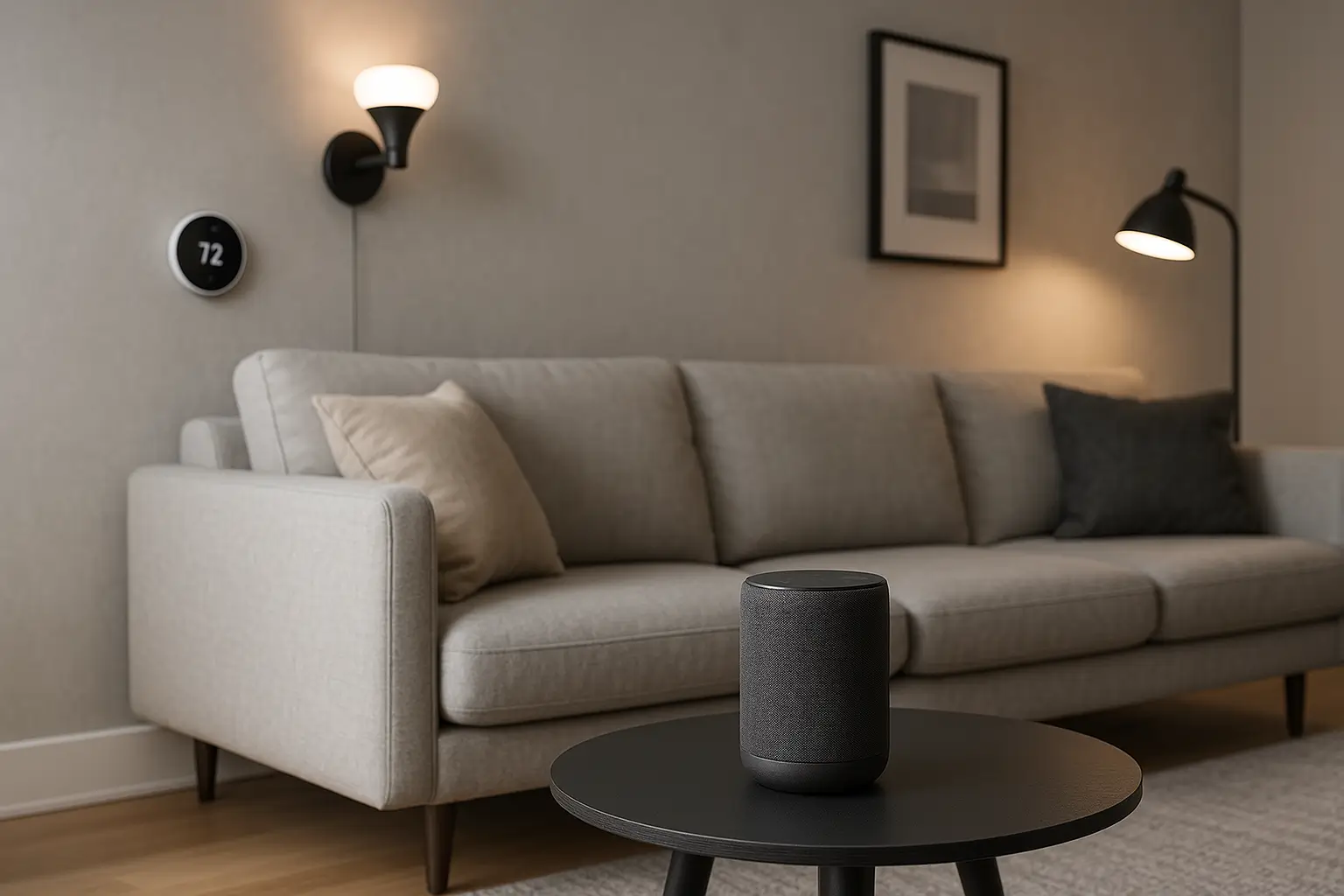Introduction to home smart devices and automation
Welcome to the world of smart homes, where your living space becomes an intelligent, responsive environment. Smart house technology has transformed how we interact with our surroundings, offering unprecedented control and convenience.
At its core, a smart home is a residence equipped with internet-connected devices that allow you to monitor and manage appliances and systems remotely. This network, often called the Internet of Things (IoT), enables you to control everything from your thermostat to your coffee maker using your smartphone or voice commands.
The home smart device landscape has grown rapidly, with tech giants like Amazon, Google, and Apple developing their own platforms and devices. This expansion has led to improved compatibility between products and smoother integration of various smart home functions.
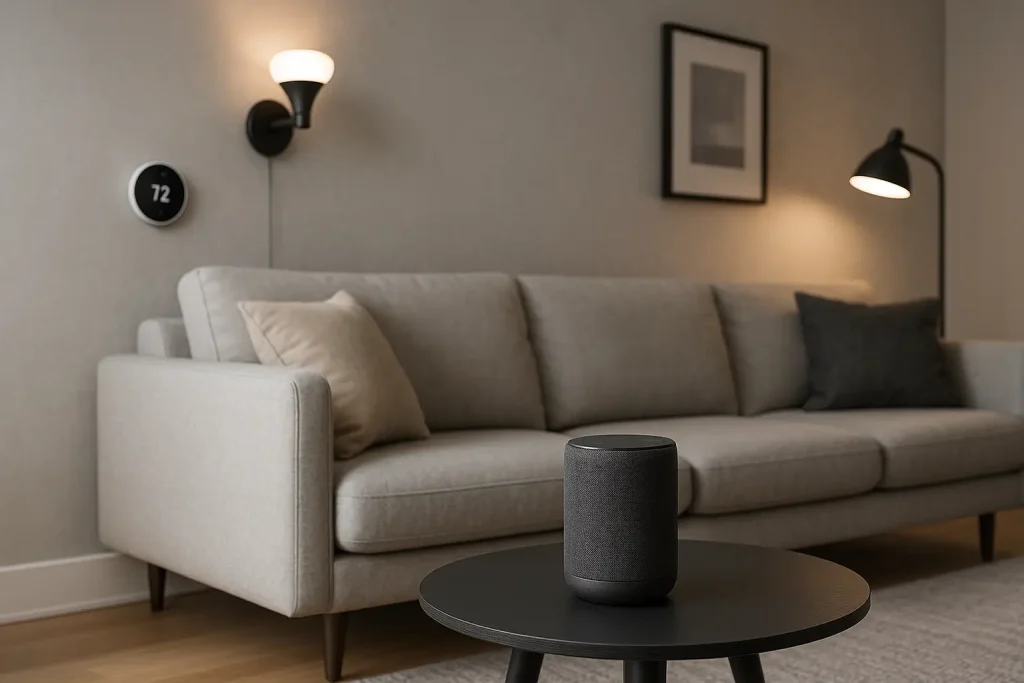
Key benefits of embracing home automation devices include:
- Boosted energy efficiency through automated climate control and power management
- Enhanced home security with connected cameras, smart locks, and motion sensors
- Increased convenience via voice control and smartphone apps
- Personalized automation of routine tasks and device interactions
- Potential savings on energy bills and insurance premiums
As this technology evolves, we’re seeing more advanced features like AI-powered assistants that learn your habits and preferences. There’s also a growing focus on data privacy and security. The introduction of new wireless standards like Matter promises to improve how devices from different manufacturers work together, creating a more seamless smart home experience.
Understanding smart house solutions: components and functionality
Now that we’ve explored the basics of smart home technology, let’s dive deeper into the components that make up these intelligent systems and how they work together to create a truly connected home.
Core Components of a Smart Home System
While setups can vary, most smart house solutions include these fundamental elements:
- Smart Hub or Controller: The central “brain” that connects and coordinates all smart devices.
- Smart Sensors: Devices that monitor environmental conditions like motion, temperature, humidity, or light levels.
- Smart Actuators: Devices that can perform physical actions, such as smart locks, motorized blinds, or smart plugs.
- User Interface: Typically a smartphone app, but can also include voice assistants, wall-mounted control panels, or web interfaces.
- Network Infrastructure: The Wi-Fi, Zigbee, Z-Wave, or other wireless protocols that enable communication between devices.

Communication Protocols and Integration
For your smart home to function smoothly, devices need to speak the same language. Several key protocols facilitate this communication:
- Wi-Fi: The most common protocol, ideal for high-bandwidth devices like cameras or smart TVs.
- Zigbee and Z-Wave: Low-power mesh networks designed specifically for smart home devices.
- Bluetooth Low Energy (BLE): Used for short-range, low-power devices like smart locks or wearables.
- Thread: A newer protocol designed to improve upon Zigbee, offering better security and lower power consumption.
- Matter: An emerging standard aiming to unify different smart home ecosystems, improving cross-platform compatibility.
Key Functionalities of Smart House Solutions
Smart home systems offer a range of functionalities that enhance comfort, efficiency, and security:
- Automated Routines: Create sequences of actions triggered by time, sensor data, or user commands.
- Remote Monitoring and Control: Access and manage your home’s systems from anywhere via smartphone apps or web interfaces.
- Energy Management: Smart thermostats and power monitoring devices can optimize energy usage, potentially leading to significant cost savings.
- Enhanced Security: Integrate smart cameras, door locks, and alarm systems for comprehensive home protection.
- Voice Control: Use natural language commands through smart speakers or mobile devices to control your home hands-free.
- Adaptive Learning: Some advanced systems use AI to learn your habits and preferences, automatically adjusting settings for optimal comfort and efficiency.
- Geofencing: Trigger actions based on your physical location, such as turning on lights when you approach home.
Understanding these components and functionalities is crucial as we move forward to explore the best smart home systems available today.
Best smart home systems: comparing top platforms and ecosystems
With a solid grasp of smart home components and functionalities, let’s now examine the leading platforms that bring these elements together. Selecting the right ecosystem is crucial for creating a cohesive and effective smart home experience.
Amazon Alexa
- Strengths: Wide selection of compatible devices, robust voice control capabilities, affordable hardware options
- Limitations: Privacy concerns, occasional accuracy issues with voice commands
- Key devices: Echo smart speakers, Echo Show displays, Ring security products
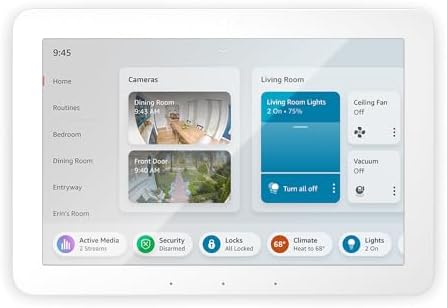
Google Home
- Strengths: Advanced AI and natural language processing, seamless integration with Google services, growing device compatibility
- Limitations: Fewer compatible devices compared to Alexa, some privacy concerns
- Key devices: Google Nest speakers and displays, Nest thermostats and cameras
Apple HomeKit
- Strengths: Strong emphasis on privacy and security, seamless integration with Apple devices, reliable performance
- Limitations: Fewer compatible devices, generally higher-priced hardware
- Key devices: HomePod speakers, Apple TV as a hub, iOS devices for control
Samsung SmartThings
- Strengths: Broad device compatibility, support for multiple protocols (Zigbee, Z-Wave), powerful automation capabilities
- Limitations: More complex setup, less intuitive for beginners
- Key devices: SmartThings hub, Samsung smart appliances
Factors to Consider When Choosing a Smart Home System
When selecting a platform for your smart home, consider the following:
- Device Compatibility: Ensure the platform supports the devices you already own or plan to purchase.
- Ease of Use: Consider the learning curve and user-friendliness of the platform’s app and voice control.
- Privacy and Security: Evaluate each platform’s approach to data protection and device security.
- Integration with Other Services: If you heavily use certain ecosystems (e.g., Google or Apple), consider how well the platform integrates with those services.
- Automation Capabilities: Assess the platform’s ability to create complex routines and automations.
- Future-Proofing: Consider support for emerging standards like Matter, which promises improved interoperability.
With these platforms in mind, let’s explore the specific devices that can transform each room of your home into a connected, intelligent space.
Essential home smart accessories for every room
Now that we’ve compared the top smart home platforms, it’s time to dive into the devices that bring these systems to life in every corner of your home.
Living Room
- Smart TV or Streaming Device: Beyond entertainment, these can serve as control centers for your smart home.
- Smart Speakers or Displays: Act as voice control hubs and provide information at a glance.
- Smart Lighting: Set the mood with color-changing bulbs or automate lighting schedules.
- Smart Blinds or Curtains: Automatically adjust based on time of day or sunlight levels.
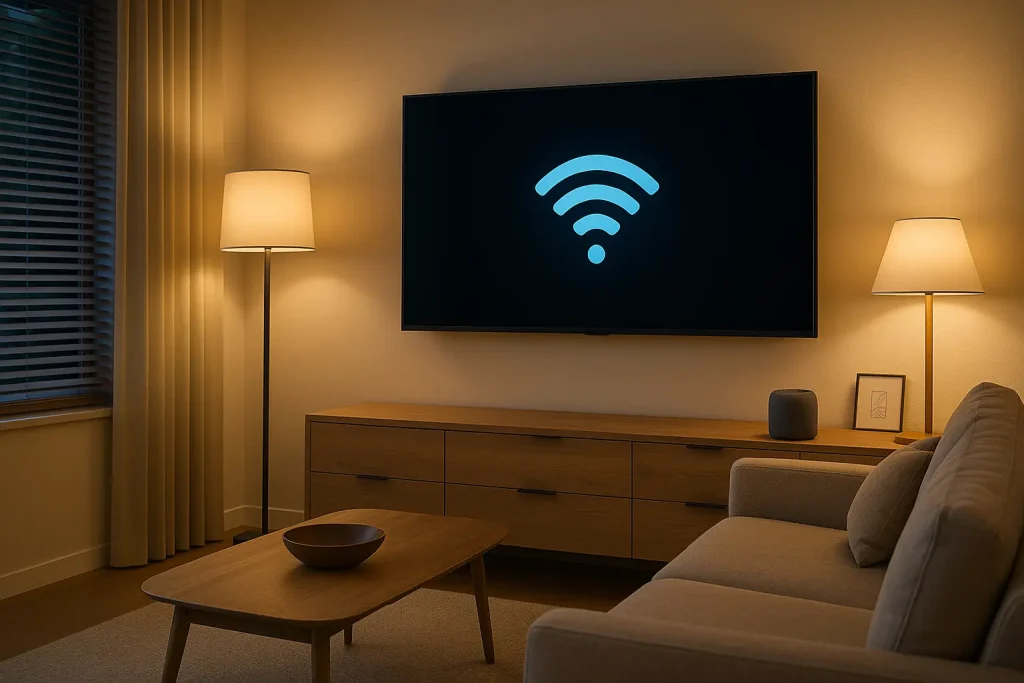
Kitchen
- Smart Refrigerator: Track groceries, suggest recipes, and even order food automatically.
- Smart Oven: Preheat remotely or receive notifications when food is ready.
- Smart Coffee Maker: Have your morning brew ready when you wake up.
- Voice-Activated Faucet: Control water flow hands-free, perfect for messy cooking situations.
Bedroom
- Smart Mattress or Sleep Tracker: Monitor sleep patterns and adjust room conditions for better rest.
- Smart Alarm Clock: Wake up gently with light that mimics sunrise.
- Smart Thermostat: Automatically adjust temperature for optimal sleeping conditions.
- Smart Air Purifier: Maintain air quality for healthier sleep.
Bathroom
- Smart Scale: Track weight, body composition, and health metrics over time.
- Smart Mirror: Display weather, news, or your calendar while you get ready.
- Smart Shower System: Precise temperature control and water usage tracking.
- Moisture Sensors: Detect leaks early to prevent water damage.
Home Office
- Smart Desk: Automatically adjust height for sitting or standing positions.
- Smart Lighting: Adjust color temperature to match natural light cycles and boost focus.
- Environmental Sensors: Monitor air quality, temperature, and humidity for optimal working conditions.
- Smart Power Strip: Control multiple devices and monitor energy usage.

As we look to the future, these home smart accessories are just the beginning. Let’s explore the exciting trends shaping the next generation of smart home technology.
Smart home technology trends for 2024 and beyond
The world of smart house technology is constantly evolving, with new innovations emerging at a rapid pace. Let’s examine some of the exciting trends and advancements that are set to shape the future of home automation:
AI and Machine Learning Integration
- Predictive Automation: Systems that learn your habits and preferences to proactively adjust settings without explicit commands.
- Natural Language Processing: More nuanced voice control that can understand context and complex requests.
- Anomaly Detection: AI-powered systems that can identify unusual patterns in home data, potentially alerting homeowners to security threats or maintenance issues.
Enhanced Energy Management
- Smart Grid Integration: Homes that can communicate with utility companies to optimize energy usage during peak and off-peak hours.
- AI-Driven Energy Optimization: Systems that analyze historical usage data, weather forecasts, and occupancy patterns to minimize energy consumption.
- Microgeneration Management: Intelligent control of home solar panels, wind turbines, and energy storage systems to maximize self-sufficiency.
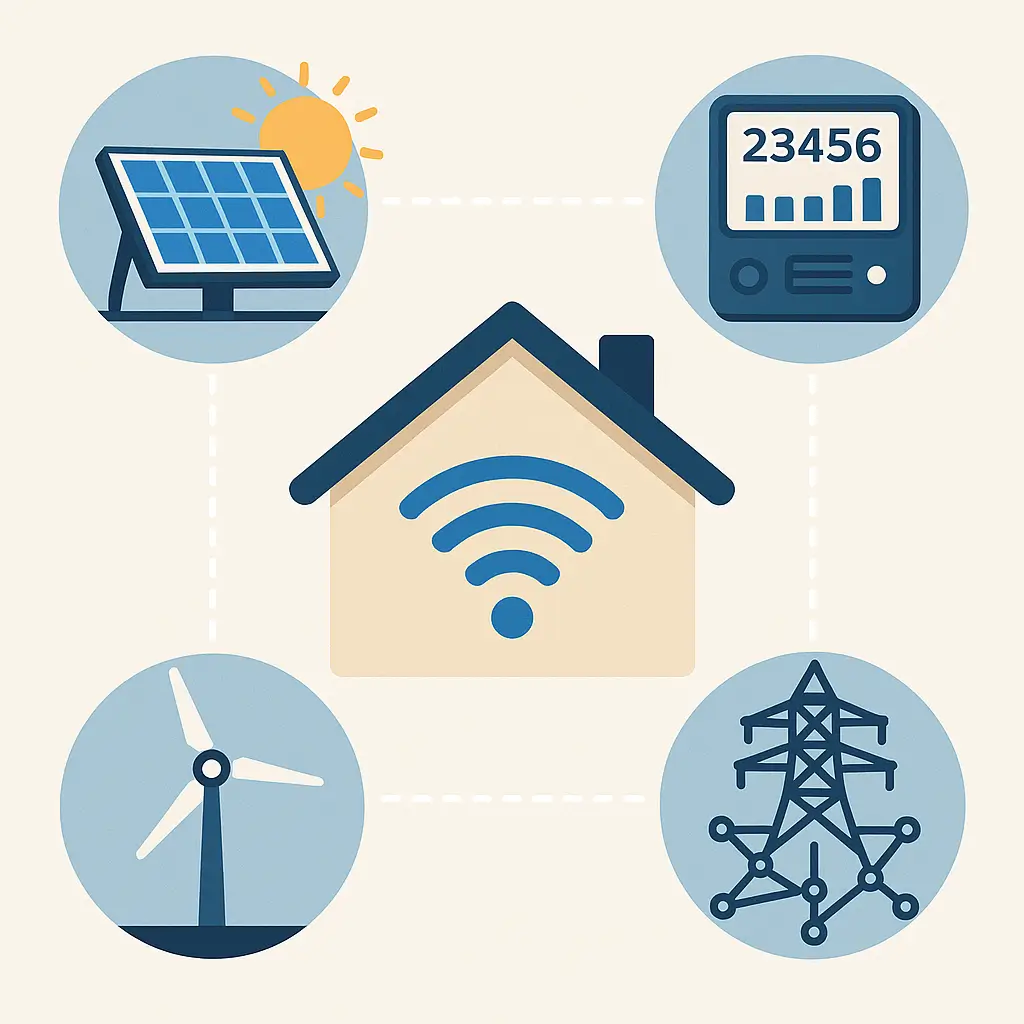
Health and Wellness Focus
- Air Quality Monitoring and Purification: Advanced systems that detect and eliminate pollutants, allergens, and pathogens.
- Circadian Lighting: Smart lighting that adjusts color temperature throughout the day to support natural sleep-wake cycles.
- Telemedicine Integration: Smart home devices that can collect and transmit health data to healthcare providers, facilitating remote consultations and monitoring.
Enhanced Interoperability
- Matter Standard Adoption: Widespread implementation of the Matter protocol, enabling seamless integration across different brands and ecosystems.
- Edge Computing: More processing power in local hubs and devices, reducing reliance on cloud services and improving response times and privacy.
- Open APIs: Greater support for third-party developers to create innovative applications that work across multiple platforms.
As these trends continue to shape the smart house 2024 landscape, it’s crucial to understand how to effectively set up and integrate these advanced technologies into your home.
Setting up and integrating your smart home devices
With an understanding of current and future smart home technologies, let’s explore the practical aspects of bringing these innovations into your home. Here’s a comprehensive guide to setting up and integrating your home control devices:
Planning Your Smart Home Setup
- Assess Your Needs: Prioritize what’s most important for your lifestyle.
- Choose Your Ecosystem: Select the platform that best aligns with your needs and existing devices.
- Consider Future Expansion: Plan for scalability, keeping in mind emerging trends.
- Budget Wisely: Allocate your budget across essential devices for each room.
Establishing Your Smart Home Foundation
- Upgrade Your Wi-Fi: Ensure your network can handle multiple connected devices.
- Set Up Your Hub: Install the central control point for your smart home.
- Secure Your Network: Implement strong passwords and enable two-factor authentication.
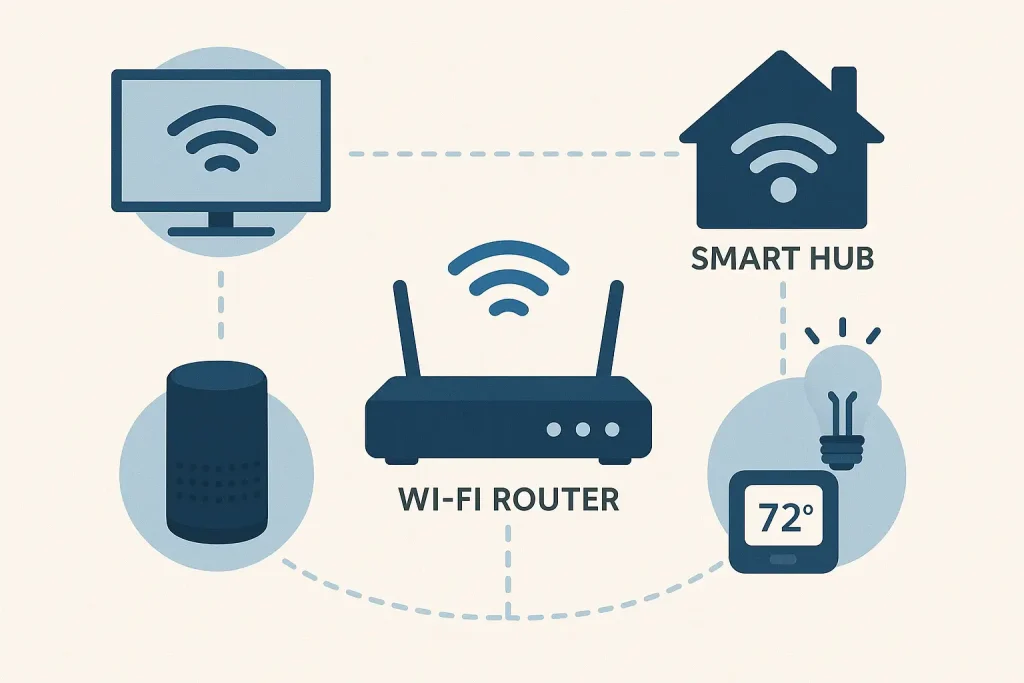
Device Installation and Configuration
- Follow Manufacturer Instructions: Each device will have specific setup procedures.
- Update Firmware: Ensure all devices have the latest software.
- Name Devices Logically: Use clear, consistent naming conventions.
- Group Devices: Organize devices by room or function in your smart home app.
Creating a Seamless Integration
- Set Up Routines: Create automated sequences that trigger multiple devices.
- Utilize Scenes: Configure preset device states for different activities or moods.
- Explore Voice Control: Familiarize yourself with voice commands for hands-free operation.
- Leverage Geofencing: Set up location-based triggers for automated actions.
With your smart home foundation in place, it’s time to explore advanced techniques for maximizing efficiency and convenience through automation.
Maximizing efficiency with home automation devices
Now that your smart home is set up and integrated, let’s take your automation to the next level with these advanced techniques:
Advanced Energy Management
- Occupancy-based HVAC control: Use motion sensors and smartphone location data to adjust heating and cooling only in occupied rooms.
- Smart power strips: Automatically cut power to devices in standby mode, eliminating phantom energy draw.
- AI-powered energy forecasting: Leverage machine learning algorithms to predict energy usage and optimize accordingly.
- Automated load shifting: Schedule high-energy tasks during off-peak hours to reduce costs and grid strain.
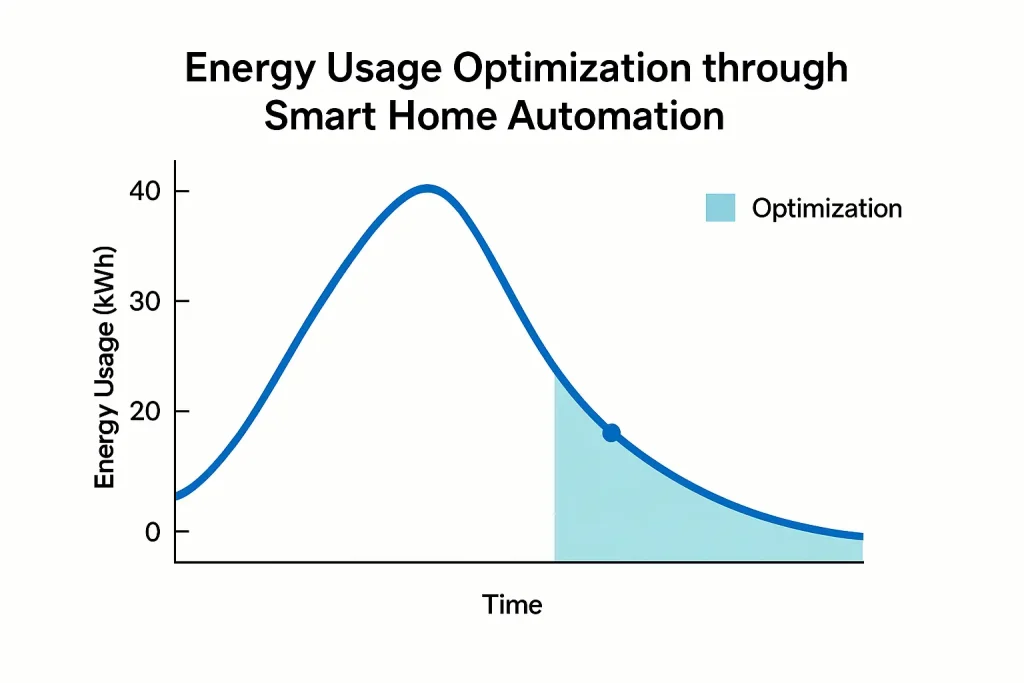
Streamlined Daily Routines
- Context-aware morning routines: Adjust wake-up times based on calendar events and traffic conditions, then trigger personalized sequences for each family member.
- Adaptive lighting scenes: Create dynamic lighting that adjusts based on natural light levels, time of day, and activities detected in each room.
- Intelligent kitchen assistance: Integrate smart appliances with voice assistants to manage recipes, cooking times, and grocery lists hands-free.
Predictive Maintenance
- HVAC performance monitoring: Use smart thermostats and additional sensors to detect inefficiencies or potential failures in heating and cooling systems.
- Water leak prediction: Analyze data from flow sensors and smart water meters to identify unusual patterns that might indicate a developing leak.
- Appliance health tracking: Monitor power consumption and performance metrics of major appliances to schedule maintenance proactively.
While these advanced automation techniques can significantly enhance your home’s efficiency and convenience, it’s crucial to consider the security and privacy implications of such a connected environment.
Security and privacy considerations for smart homes
As we embrace the convenience and efficiency of smart house technology, it’s essential to address the potential vulnerabilities that come with a more connected living space. Let’s explore the key security and privacy considerations for smart homes:
Evolving Security Landscape
- Expanded attack surface: Each new device added to your network represents a potential entry point for malicious actors.
- Data breaches: The vast amount of personal data collected by smart devices makes them attractive targets for cybercriminals.
- Firmware vulnerabilities: Outdated firmware can leave devices exposed to known exploits.
- Botnet recruitment: Unsecured devices can be hijacked to participate in large-scale cyberattacks.
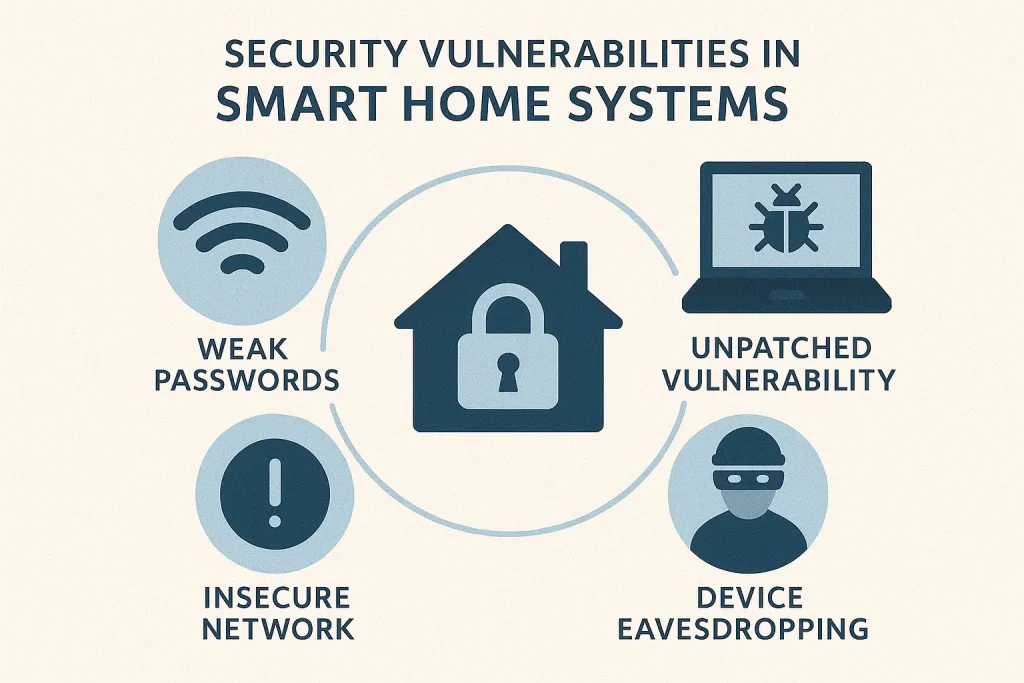
Privacy Challenges in the Connected Home
- Always-on sensors: Devices like smart speakers and cameras are constantly monitoring their environment, potentially capturing sensitive information.
- Data aggregation: The combination of data from multiple devices can create detailed profiles of household activities and habits.
- Third-party access: Many smart home platforms share data with partners or use cloud-based processing, expanding the circle of entities with access to your information.
Advanced Security Measures
- Network segmentation: Create a separate Wi-Fi network for smart home devices to isolate them from your main network.
- Intrusion detection systems: Deploy network monitoring tools to alert you to unusual activity or potential breaches.
- End-to-end encryption: Prioritize devices and platforms that offer strong encryption for both data in transit and at rest.
- Multi-factor authentication: Enable MFA for all smart home accounts and device access where possible.
Privacy-Enhancing Strategies
- Data minimization: Regularly review and adjust the data collection settings on your devices to limit unnecessary information gathering.
- Local processing: Prioritize devices that can process data locally rather than sending it to the cloud.
- Privacy-focused ecosystems: Consider platforms like Apple HomeKit that emphasize privacy in their design and policies.
- Regular privacy audits: Periodically review the privacy policies of your smart home devices and services, and reassess your comfort level with their data practices.
By implementing robust security measures, adopting privacy-enhancing strategies, and staying informed about both technological advancements and regulatory developments, you can create a smart home environment that is not only efficient and comfortable but also secure and respectful of your personal privacy.
Conclusion: Embracing the Future of Smart Home Living
As we’ve explored throughout this guide, smart house technology offers unprecedented opportunities to enhance our living spaces with convenience, efficiency, and automation. From voice-controlled lighting to AI-powered energy management, the possibilities are expanding rapidly.
However, with great power comes great responsibility. As you embark on your smart home journey, remember to prioritize security and privacy alongside functionality. Regularly update your devices, use strong passwords, and be mindful of the data you’re sharing.
The future of smart homes is bright, with emerging technologies like AI, edge computing, and advanced interoperability standards promising even more seamless and intuitive experiences. By staying informed and making thoughtful choices about the devices and systems you incorporate into your home, you can create a living space that truly enhances your daily life.
Take the next step in your smart home journey today. Start small, perhaps with a smart speaker or a few connected light bulbs, and gradually expand your system as you become more comfortable with the technology. Remember, the goal is to create a home that works for you, making your life easier, more efficient, and more enjoyable.
As you explore the world of home smart devices, you might be interested in learning about the latest innovations in mobile technology. For instance, our comprehensive review of the iPhone 15 Pro covers its cutting-edge features, including the powerful A17 Pro chip, durable titanium frame, and versatile USB-C port. Understanding these advancements can help you make informed decisions about how to integrate your smartphone with your smart home ecosystem, creating a truly connected and efficient living space.
References
1. Statista Research Department. (2023). Smart Home – worldwide. Statista. https://www.statista.com/outlook/cmo/smart-home/worldwide
2. Gartner. (2023). Gartner Identifies Top Five Trends in Privacy Through 2024. https://www.gartner.com/en/newsroom/press-releases/2022-05-31-gartner-identifies-top-five-trends-in-privacy-through-2024
3. Matter. (2023). Build with Matter. Connectivity Standards Alliance. https://csa-iot.org/all-solutions/matter/

